CEMEX: An In-Depth Situational Analysis and Strategic Plan Project
VerifiedAdded on 2021/09/08
|40
|10585
|211
Project
AI Summary
This project provides an in-depth situational analysis and strategic plan for CEMEX, a global building materials company. The report begins with an overview of CEMEX's history, industry characteristics, product offerings (cement, aggregates, and concrete), and operational structure, including its global presence and commitment to operational efficiency and sustainability. It then delves into a detailed situational analysis, examining external factors such as the competitive landscape, bargaining power of buyers and suppliers, and the threat of substitutes and new entrants. An internal analysis assesses CEMEX's target customer segments, logistics, operations, marketing, customer service, and IT infrastructure. Business models, international strategy (aggregation, arbitrage, adaptation), and financial conditions are also explored. The report concludes with strategic options for CEMEX, including company expansion, expansion of the Patrimonio Hoy program, and divestiture of assets. The project highlights the company's focus on flexibility, creativity, sustainability, innovation, and efficiency in the building materials industry.
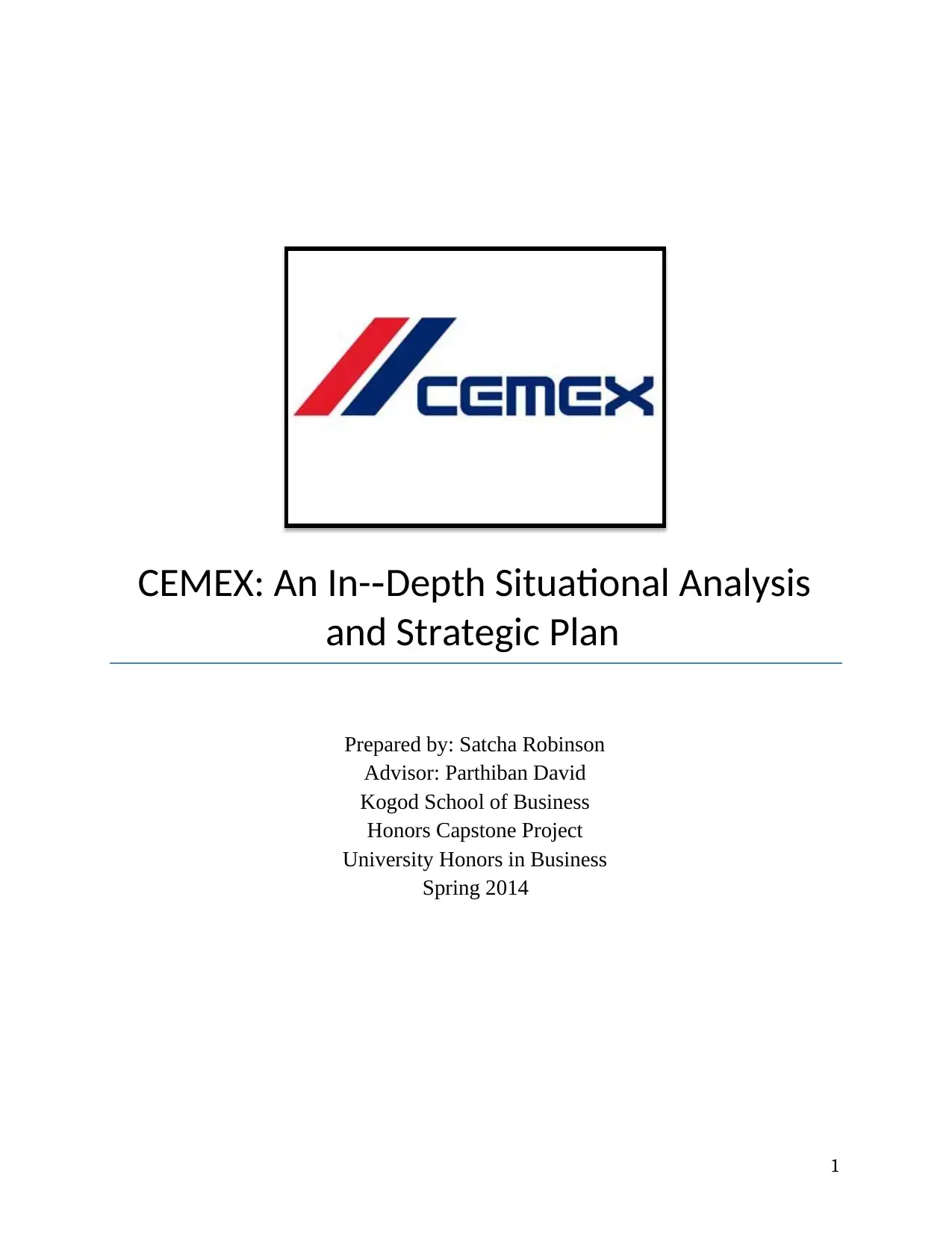
1
CEMEX: An In- Depth Situational Analysis‐
and Strategic Plan
Prepared by: Satcha Robinson
Advisor: Parthiban David
Kogod School of Business
Honors Capstone Project
University Honors in Business
Spring 2014
CEMEX: An In- Depth Situational Analysis‐
and Strategic Plan
Prepared by: Satcha Robinson
Advisor: Parthiban David
Kogod School of Business
Honors Capstone Project
University Honors in Business
Spring 2014
Paraphrase This Document
Need a fresh take? Get an instant paraphrase of this document with our AI Paraphraser
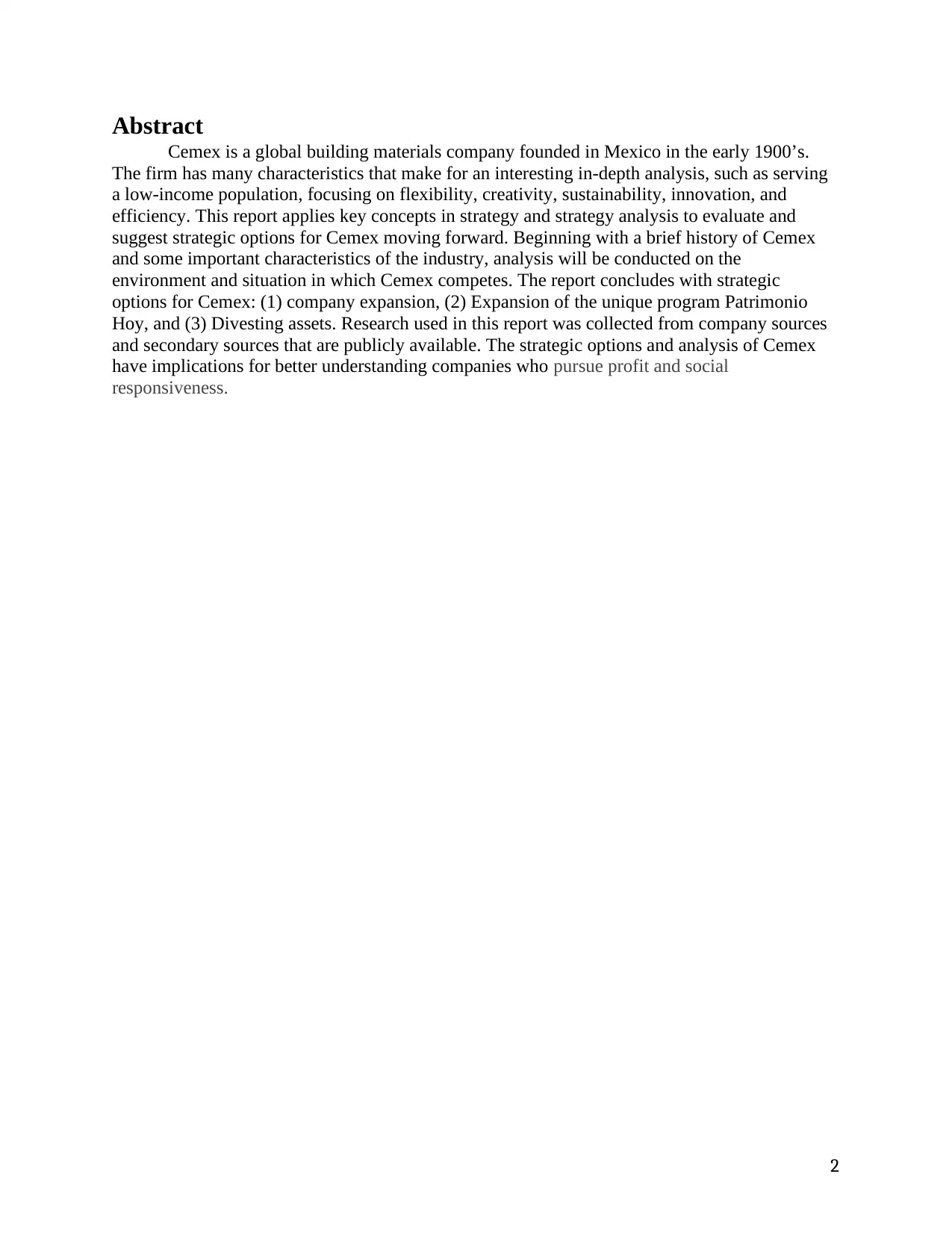
2
Abstract
Cemex is a global building materials company founded in Mexico in the early 1900’s.
The firm has many characteristics that make for an interesting in-depth analysis, such as serving
a low-income population, focusing on flexibility, creativity, sustainability, innovation, and
efficiency. This report applies key concepts in strategy and strategy analysis to evaluate and
suggest strategic options for Cemex moving forward. Beginning with a brief history of Cemex
and some important characteristics of the industry, analysis will be conducted on the
environment and situation in which Cemex competes. The report concludes with strategic
options for Cemex: (1) company expansion, (2) Expansion of the unique program Patrimonio
Hoy, and (3) Divesting assets. Research used in this report was collected from company sources
and secondary sources that are publicly available. The strategic options and analysis of Cemex
have implications for better understanding companies who pursue profit and social
responsiveness.
Abstract
Cemex is a global building materials company founded in Mexico in the early 1900’s.
The firm has many characteristics that make for an interesting in-depth analysis, such as serving
a low-income population, focusing on flexibility, creativity, sustainability, innovation, and
efficiency. This report applies key concepts in strategy and strategy analysis to evaluate and
suggest strategic options for Cemex moving forward. Beginning with a brief history of Cemex
and some important characteristics of the industry, analysis will be conducted on the
environment and situation in which Cemex competes. The report concludes with strategic
options for Cemex: (1) company expansion, (2) Expansion of the unique program Patrimonio
Hoy, and (3) Divesting assets. Research used in this report was collected from company sources
and secondary sources that are publicly available. The strategic options and analysis of Cemex
have implications for better understanding companies who pursue profit and social
responsiveness.
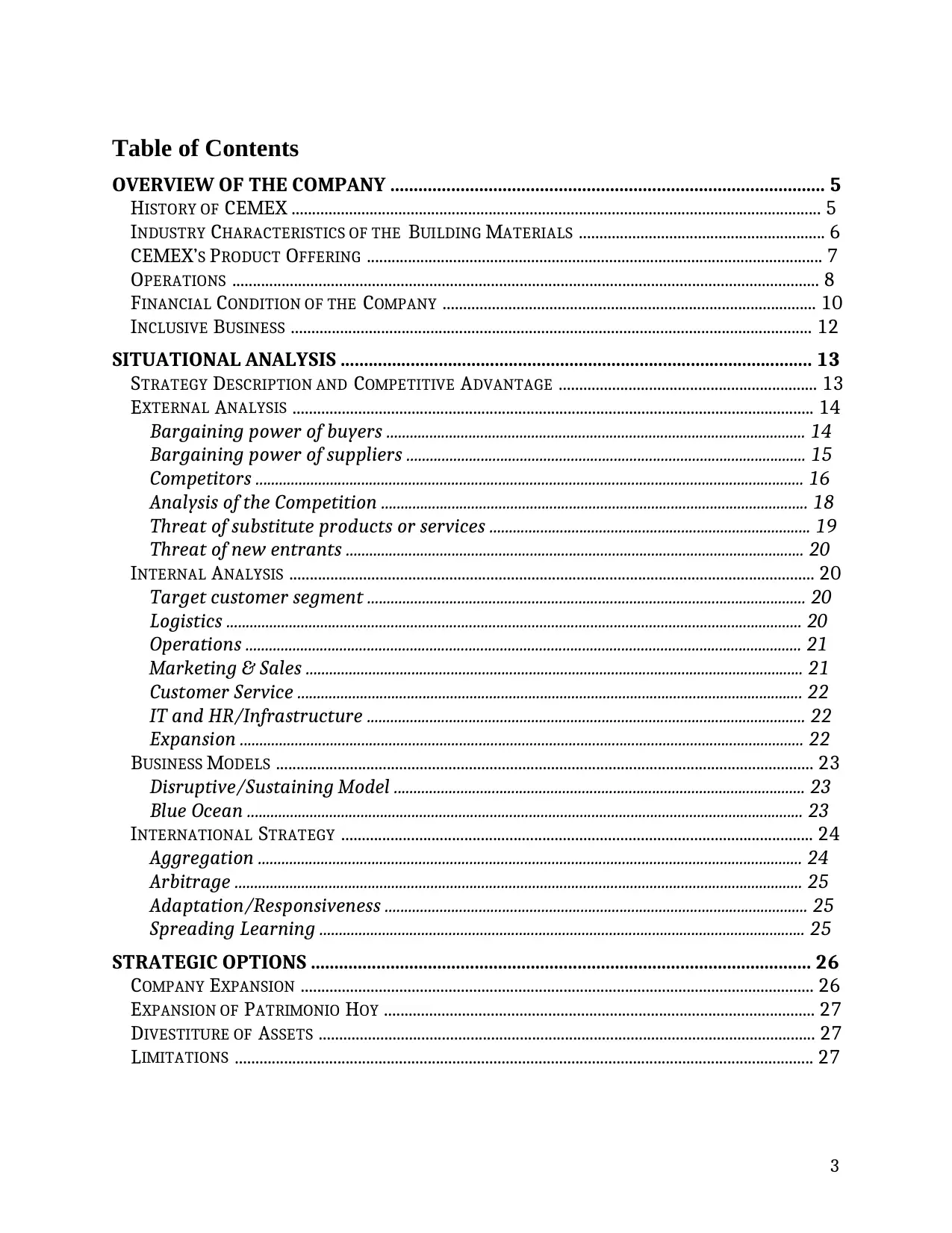
3
Table of Contents
OVERVIEW OF THE COMPANY ............................................................................................. 5
HISTORY OF CEMEX ................................................................................................................................. 5
INDUSTRY CHARACTERISTICS OF THE BUILDING MATERIALS ............................................................ 6
CEMEX’S PRODUCT OFFERING ............................................................................................................... 7
OPERATIONS ............................................................................................................................................... 8
FINANCIAL CONDITION OF THE COMPANY ........................................................................................... 10
INCLUSIVE BUSINESS ............................................................................................................................... 12
SITUATIONAL ANALYSIS ..................................................................................................... 13
STRATEGY DESCRIPTION AND COMPETITIVE ADVANTAGE ............................................................... 13
EXTERNAL ANALYSIS ............................................................................................................................... 14
Bargaining power of buyers ........................................................................................................... 14
Bargaining power of suppliers ...................................................................................................... 15
Competitors ............................................................................................................................................ 16
Analysis of the Competition ............................................................................................................. 18
Threat of substitute products or services .................................................................................. 19
Threat of new entrants ..................................................................................................................... 20
INTERNAL ANALYSIS ................................................................................................................................ 20
Target customer segment ................................................................................................................ 20
Logistics ................................................................................................................................................... 20
Operations .............................................................................................................................................. 21
Marketing & Sales ............................................................................................................................... 21
Customer Service ................................................................................................................................. 22
IT and HR/Infrastructure ................................................................................................................ 22
Expansion ................................................................................................................................................ 22
BUSINESS MODELS ................................................................................................................................... 23
Disruptive/Sustaining Model ......................................................................................................... 23
Blue Ocean .............................................................................................................................................. 23
INTERNATIONAL STRATEGY ................................................................................................................... 24
Aggregation ........................................................................................................................................... 24
Arbitrage ................................................................................................................................................. 25
Adaptation/Responsiveness ............................................................................................................ 25
Spreading Learning ............................................................................................................................ 25
STRATEGIC OPTIONS ........................................................................................................... 26
COMPANY EXPANSION ............................................................................................................................. 26
EXPANSION OF PATRIMONIO HOY ......................................................................................................... 27
DIVESTITURE OF ASSETS ......................................................................................................................... 27
LIMITATIONS ............................................................................................................................................. 27
Table of Contents
OVERVIEW OF THE COMPANY ............................................................................................. 5
HISTORY OF CEMEX ................................................................................................................................. 5
INDUSTRY CHARACTERISTICS OF THE BUILDING MATERIALS ............................................................ 6
CEMEX’S PRODUCT OFFERING ............................................................................................................... 7
OPERATIONS ............................................................................................................................................... 8
FINANCIAL CONDITION OF THE COMPANY ........................................................................................... 10
INCLUSIVE BUSINESS ............................................................................................................................... 12
SITUATIONAL ANALYSIS ..................................................................................................... 13
STRATEGY DESCRIPTION AND COMPETITIVE ADVANTAGE ............................................................... 13
EXTERNAL ANALYSIS ............................................................................................................................... 14
Bargaining power of buyers ........................................................................................................... 14
Bargaining power of suppliers ...................................................................................................... 15
Competitors ............................................................................................................................................ 16
Analysis of the Competition ............................................................................................................. 18
Threat of substitute products or services .................................................................................. 19
Threat of new entrants ..................................................................................................................... 20
INTERNAL ANALYSIS ................................................................................................................................ 20
Target customer segment ................................................................................................................ 20
Logistics ................................................................................................................................................... 20
Operations .............................................................................................................................................. 21
Marketing & Sales ............................................................................................................................... 21
Customer Service ................................................................................................................................. 22
IT and HR/Infrastructure ................................................................................................................ 22
Expansion ................................................................................................................................................ 22
BUSINESS MODELS ................................................................................................................................... 23
Disruptive/Sustaining Model ......................................................................................................... 23
Blue Ocean .............................................................................................................................................. 23
INTERNATIONAL STRATEGY ................................................................................................................... 24
Aggregation ........................................................................................................................................... 24
Arbitrage ................................................................................................................................................. 25
Adaptation/Responsiveness ............................................................................................................ 25
Spreading Learning ............................................................................................................................ 25
STRATEGIC OPTIONS ........................................................................................................... 26
COMPANY EXPANSION ............................................................................................................................. 26
EXPANSION OF PATRIMONIO HOY ......................................................................................................... 27
DIVESTITURE OF ASSETS ......................................................................................................................... 27
LIMITATIONS ............................................................................................................................................. 27
⊘ This is a preview!⊘
Do you want full access?
Subscribe today to unlock all pages.

Trusted by 1+ million students worldwide
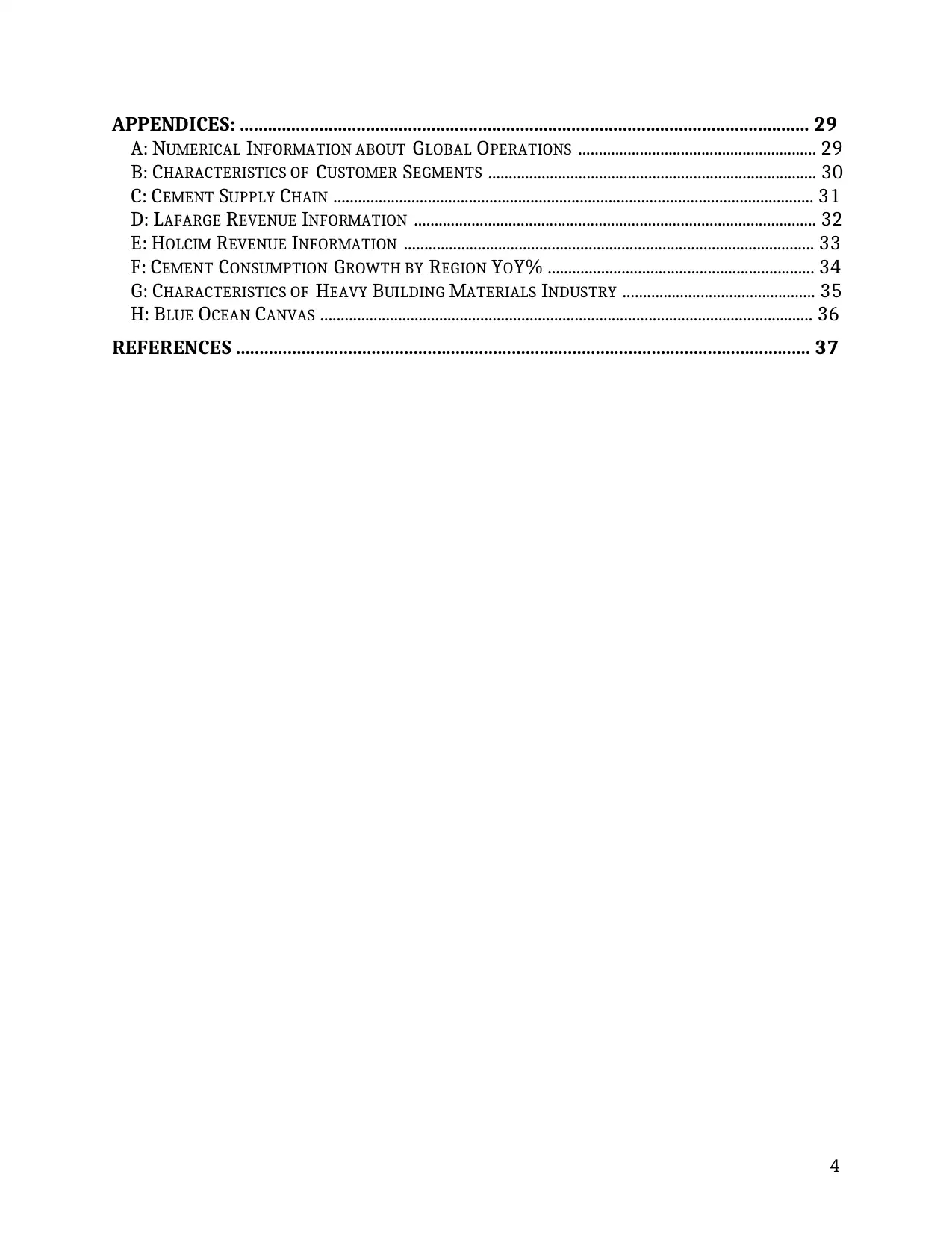
4
APPENDICES: .......................................................................................................................... 29
A: NUMERICAL INFORMATION ABOUT GLOBAL OPERATIONS .......................................................... 29
B: CHARACTERISTICS OF CUSTOMER SEGMENTS ................................................................................ 30
C: CEMENT SUPPLY CHAIN ..................................................................................................................... 31
D: LAFARGE REVENUE INFORMATION .................................................................................................. 32
E: HOLCIM REVENUE INFORMATION .................................................................................................... 33
F: CEMENT CONSUMPTION GROWTH BY REGION YOY% ................................................................. 34
G: CHARACTERISTICS OF HEAVY BUILDING MATERIALS INDUSTRY ............................................... 35
H: BLUE OCEAN CANVAS ........................................................................................................................ 36
REFERENCES ........................................................................................................................... 37
APPENDICES: .......................................................................................................................... 29
A: NUMERICAL INFORMATION ABOUT GLOBAL OPERATIONS .......................................................... 29
B: CHARACTERISTICS OF CUSTOMER SEGMENTS ................................................................................ 30
C: CEMENT SUPPLY CHAIN ..................................................................................................................... 31
D: LAFARGE REVENUE INFORMATION .................................................................................................. 32
E: HOLCIM REVENUE INFORMATION .................................................................................................... 33
F: CEMENT CONSUMPTION GROWTH BY REGION YOY% ................................................................. 34
G: CHARACTERISTICS OF HEAVY BUILDING MATERIALS INDUSTRY ............................................... 35
H: BLUE OCEAN CANVAS ........................................................................................................................ 36
REFERENCES ........................................................................................................................... 37
Paraphrase This Document
Need a fresh take? Get an instant paraphrase of this document with our AI Paraphraser
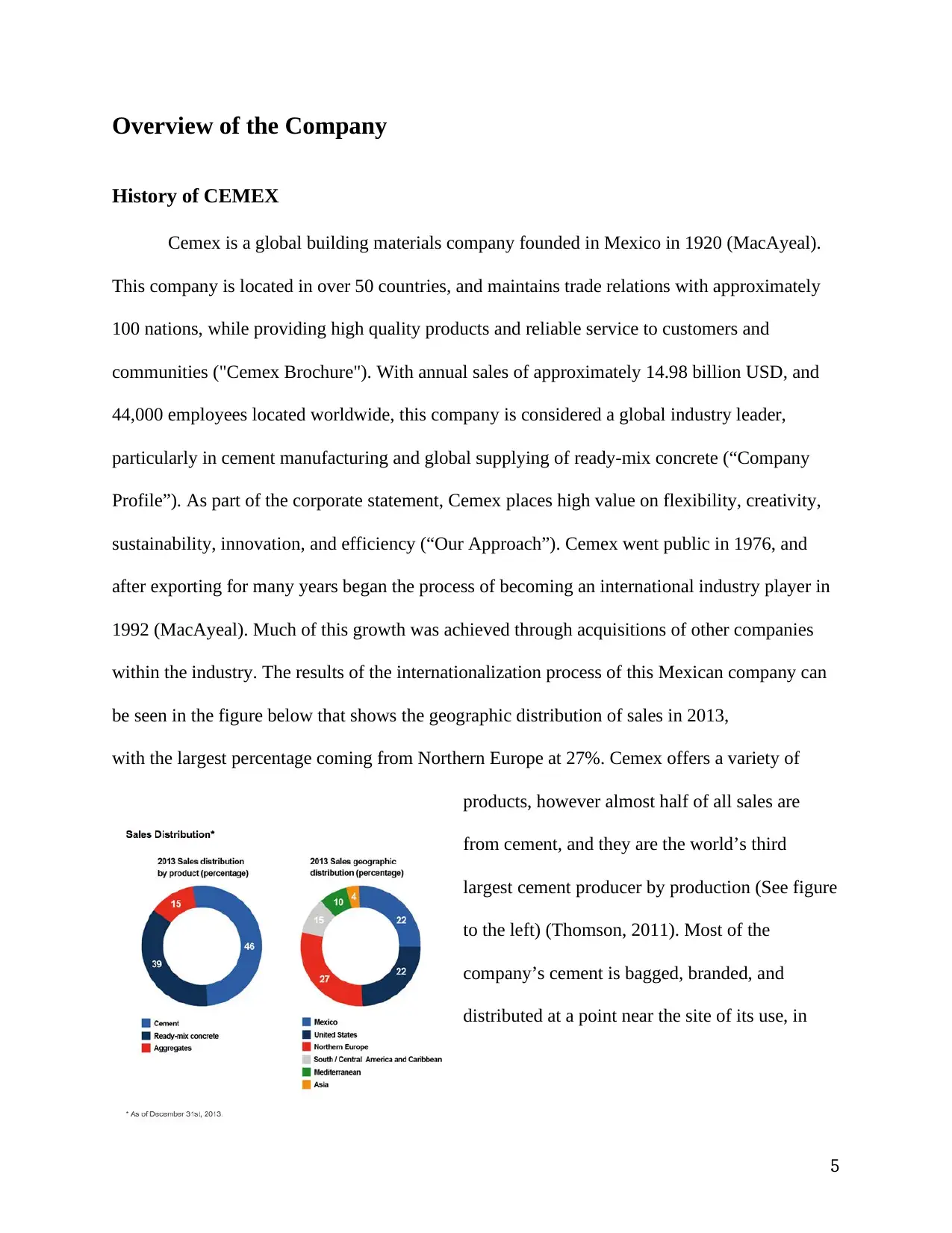
5
Overview of the Company
History of CEMEX
Cemex is a global building materials company founded in Mexico in 1920 (MacAyeal).
This company is located in over 50 countries, and maintains trade relations with approximately
100 nations, while providing high quality products and reliable service to customers and
communities ("Cemex Brochure"). With annual sales of approximately 14.98 billion USD, and
44,000 employees located worldwide, this company is considered a global industry leader,
particularly in cement manufacturing and global supplying of ready-mix concrete (“Company
Profile”). As part of the corporate statement, Cemex places high value on flexibility, creativity,
sustainability, innovation, and efficiency (“Our Approach”). Cemex went public in 1976, and
after exporting for many years began the process of becoming an international industry player in
1992 (MacAyeal). Much of this growth was achieved through acquisitions of other companies
within the industry. The results of the internationalization process of this Mexican company can
be seen in the figure below that shows the geographic distribution of sales in 2013,
with the largest percentage coming from Northern Europe at 27%. Cemex offers a variety of
products, however almost half of all sales are
from cement, and they are the world’s third
largest cement producer by production (See figure
to the left) (Thomson, 2011). Most of the
company’s cement is bagged, branded, and
distributed at a point near the site of its use, in
Overview of the Company
History of CEMEX
Cemex is a global building materials company founded in Mexico in 1920 (MacAyeal).
This company is located in over 50 countries, and maintains trade relations with approximately
100 nations, while providing high quality products and reliable service to customers and
communities ("Cemex Brochure"). With annual sales of approximately 14.98 billion USD, and
44,000 employees located worldwide, this company is considered a global industry leader,
particularly in cement manufacturing and global supplying of ready-mix concrete (“Company
Profile”). As part of the corporate statement, Cemex places high value on flexibility, creativity,
sustainability, innovation, and efficiency (“Our Approach”). Cemex went public in 1976, and
after exporting for many years began the process of becoming an international industry player in
1992 (MacAyeal). Much of this growth was achieved through acquisitions of other companies
within the industry. The results of the internationalization process of this Mexican company can
be seen in the figure below that shows the geographic distribution of sales in 2013,
with the largest percentage coming from Northern Europe at 27%. Cemex offers a variety of
products, however almost half of all sales are
from cement, and they are the world’s third
largest cement producer by production (See figure
to the left) (Thomson, 2011). Most of the
company’s cement is bagged, branded, and
distributed at a point near the site of its use, in
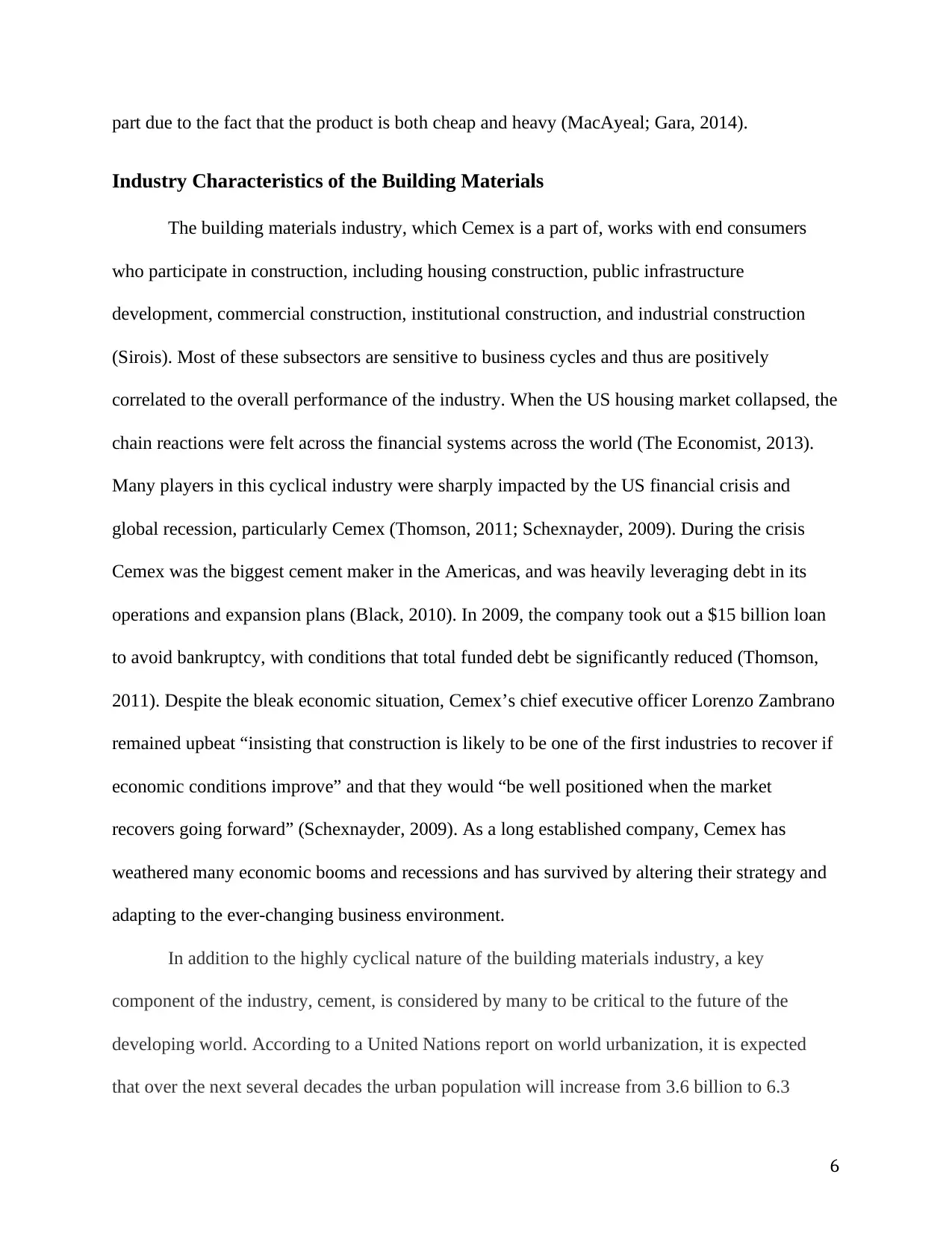
6
part due to the fact that the product is both cheap and heavy (MacAyeal; Gara, 2014).
Industry Characteristics of the Building Materials
The building materials industry, which Cemex is a part of, works with end consumers
who participate in construction, including housing construction, public infrastructure
development, commercial construction, institutional construction, and industrial construction
(Sirois). Most of these subsectors are sensitive to business cycles and thus are positively
correlated to the overall performance of the industry. When the US housing market collapsed, the
chain reactions were felt across the financial systems across the world (The Economist, 2013).
Many players in this cyclical industry were sharply impacted by the US financial crisis and
global recession, particularly Cemex (Thomson, 2011; Schexnayder, 2009). During the crisis
Cemex was the biggest cement maker in the Americas, and was heavily leveraging debt in its
operations and expansion plans (Black, 2010). In 2009, the company took out a $15 billion loan
to avoid bankruptcy, with conditions that total funded debt be significantly reduced (Thomson,
2011). Despite the bleak economic situation, Cemex’s chief executive officer Lorenzo Zambrano
remained upbeat “insisting that construction is likely to be one of the first industries to recover if
economic conditions improve” and that they would “be well positioned when the market
recovers going forward” (Schexnayder, 2009). As a long established company, Cemex has
weathered many economic booms and recessions and has survived by altering their strategy and
adapting to the ever-changing business environment.
In addition to the highly cyclical nature of the building materials industry, a key
component of the industry, cement, is considered by many to be critical to the future of the
developing world. According to a United Nations report on world urbanization, it is expected
that over the next several decades the urban population will increase from 3.6 billion to 6.3
part due to the fact that the product is both cheap and heavy (MacAyeal; Gara, 2014).
Industry Characteristics of the Building Materials
The building materials industry, which Cemex is a part of, works with end consumers
who participate in construction, including housing construction, public infrastructure
development, commercial construction, institutional construction, and industrial construction
(Sirois). Most of these subsectors are sensitive to business cycles and thus are positively
correlated to the overall performance of the industry. When the US housing market collapsed, the
chain reactions were felt across the financial systems across the world (The Economist, 2013).
Many players in this cyclical industry were sharply impacted by the US financial crisis and
global recession, particularly Cemex (Thomson, 2011; Schexnayder, 2009). During the crisis
Cemex was the biggest cement maker in the Americas, and was heavily leveraging debt in its
operations and expansion plans (Black, 2010). In 2009, the company took out a $15 billion loan
to avoid bankruptcy, with conditions that total funded debt be significantly reduced (Thomson,
2011). Despite the bleak economic situation, Cemex’s chief executive officer Lorenzo Zambrano
remained upbeat “insisting that construction is likely to be one of the first industries to recover if
economic conditions improve” and that they would “be well positioned when the market
recovers going forward” (Schexnayder, 2009). As a long established company, Cemex has
weathered many economic booms and recessions and has survived by altering their strategy and
adapting to the ever-changing business environment.
In addition to the highly cyclical nature of the building materials industry, a key
component of the industry, cement, is considered by many to be critical to the future of the
developing world. According to a United Nations report on world urbanization, it is expected
that over the next several decades the urban population will increase from 3.6 billion to 6.3
⊘ This is a preview!⊘
Do you want full access?
Subscribe today to unlock all pages.

Trusted by 1+ million students worldwide
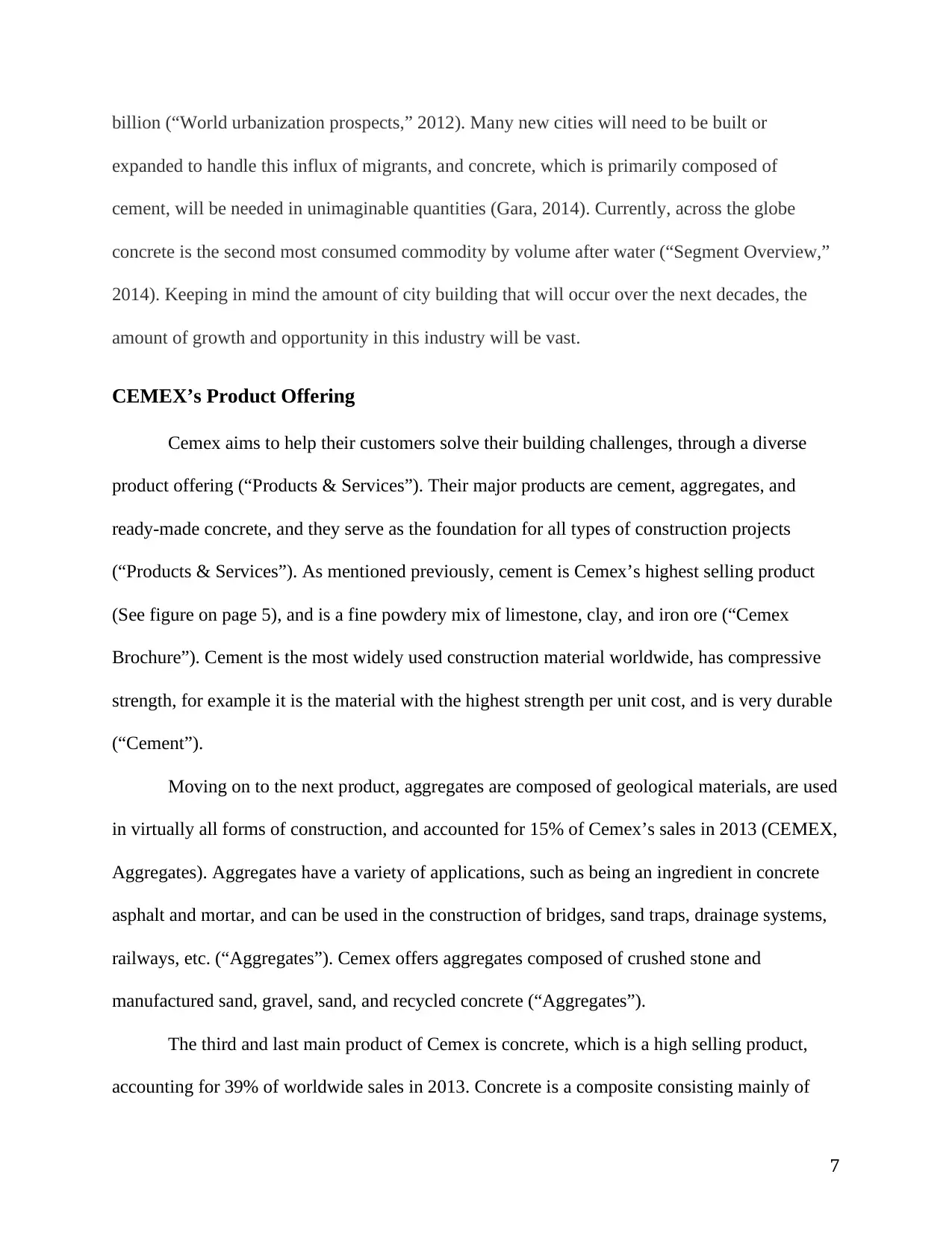
7
billion (“World urbanization prospects,” 2012). Many new cities will need to be built or
expanded to handle this influx of migrants, and concrete, which is primarily composed of
cement, will be needed in unimaginable quantities (Gara, 2014). Currently, across the globe
concrete is the second most consumed commodity by volume after water (“Segment Overview,”
2014). Keeping in mind the amount of city building that will occur over the next decades, the
amount of growth and opportunity in this industry will be vast.
CEMEX’s Product Offering
Cemex aims to help their customers solve their building challenges, through a diverse
product offering (“Products & Services”). Their major products are cement, aggregates, and
ready-made concrete, and they serve as the foundation for all types of construction projects
(“Products & Services”). As mentioned previously, cement is Cemex’s highest selling product
(See figure on page 5), and is a fine powdery mix of limestone, clay, and iron ore (“Cemex
Brochure”). Cement is the most widely used construction material worldwide, has compressive
strength, for example it is the material with the highest strength per unit cost, and is very durable
(“Cement”).
Moving on to the next product, aggregates are composed of geological materials, are used
in virtually all forms of construction, and accounted for 15% of Cemex’s sales in 2013 (CEMEX,
Aggregates). Aggregates have a variety of applications, such as being an ingredient in concrete
asphalt and mortar, and can be used in the construction of bridges, sand traps, drainage systems,
railways, etc. (“Aggregates”). Cemex offers aggregates composed of crushed stone and
manufactured sand, gravel, sand, and recycled concrete (“Aggregates”).
The third and last main product of Cemex is concrete, which is a high selling product,
accounting for 39% of worldwide sales in 2013. Concrete is a composite consisting mainly of
billion (“World urbanization prospects,” 2012). Many new cities will need to be built or
expanded to handle this influx of migrants, and concrete, which is primarily composed of
cement, will be needed in unimaginable quantities (Gara, 2014). Currently, across the globe
concrete is the second most consumed commodity by volume after water (“Segment Overview,”
2014). Keeping in mind the amount of city building that will occur over the next decades, the
amount of growth and opportunity in this industry will be vast.
CEMEX’s Product Offering
Cemex aims to help their customers solve their building challenges, through a diverse
product offering (“Products & Services”). Their major products are cement, aggregates, and
ready-made concrete, and they serve as the foundation for all types of construction projects
(“Products & Services”). As mentioned previously, cement is Cemex’s highest selling product
(See figure on page 5), and is a fine powdery mix of limestone, clay, and iron ore (“Cemex
Brochure”). Cement is the most widely used construction material worldwide, has compressive
strength, for example it is the material with the highest strength per unit cost, and is very durable
(“Cement”).
Moving on to the next product, aggregates are composed of geological materials, are used
in virtually all forms of construction, and accounted for 15% of Cemex’s sales in 2013 (CEMEX,
Aggregates). Aggregates have a variety of applications, such as being an ingredient in concrete
asphalt and mortar, and can be used in the construction of bridges, sand traps, drainage systems,
railways, etc. (“Aggregates”). Cemex offers aggregates composed of crushed stone and
manufactured sand, gravel, sand, and recycled concrete (“Aggregates”).
The third and last main product of Cemex is concrete, which is a high selling product,
accounting for 39% of worldwide sales in 2013. Concrete is a composite consisting mainly of
Paraphrase This Document
Need a fresh take? Get an instant paraphrase of this document with our AI Paraphraser
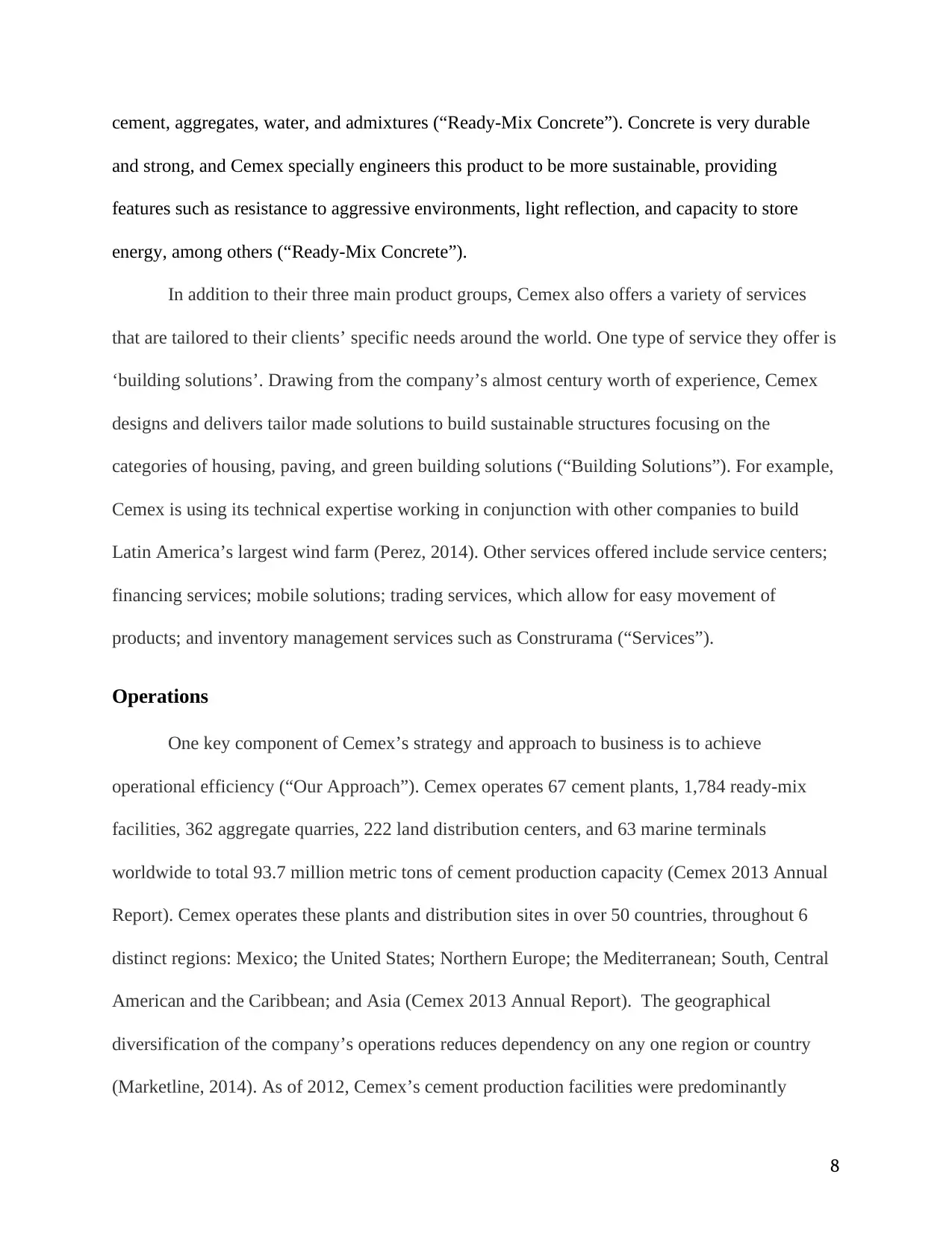
8
cement, aggregates, water, and admixtures (“Ready-Mix Concrete”). Concrete is very durable
and strong, and Cemex specially engineers this product to be more sustainable, providing
features such as resistance to aggressive environments, light reflection, and capacity to store
energy, among others (“Ready-Mix Concrete”).
In addition to their three main product groups, Cemex also offers a variety of services
that are tailored to their clients’ specific needs around the world. One type of service they offer is
‘building solutions’. Drawing from the company’s almost century worth of experience, Cemex
designs and delivers tailor made solutions to build sustainable structures focusing on the
categories of housing, paving, and green building solutions (“Building Solutions”). For example,
Cemex is using its technical expertise working in conjunction with other companies to build
Latin America’s largest wind farm (Perez, 2014). Other services offered include service centers;
financing services; mobile solutions; trading services, which allow for easy movement of
products; and inventory management services such as Construrama (“Services”).
Operations
One key component of Cemex’s strategy and approach to business is to achieve
operational efficiency (“Our Approach”). Cemex operates 67 cement plants, 1,784 ready-mix
facilities, 362 aggregate quarries, 222 land distribution centers, and 63 marine terminals
worldwide to total 93.7 million metric tons of cement production capacity (Cemex 2013 Annual
Report). Cemex operates these plants and distribution sites in over 50 countries, throughout 6
distinct regions: Mexico; the United States; Northern Europe; the Mediterranean; South, Central
American and the Caribbean; and Asia (Cemex 2013 Annual Report). The geographical
diversification of the company’s operations reduces dependency on any one region or country
(Marketline, 2014). As of 2012, Cemex’s cement production facilities were predominantly
cement, aggregates, water, and admixtures (“Ready-Mix Concrete”). Concrete is very durable
and strong, and Cemex specially engineers this product to be more sustainable, providing
features such as resistance to aggressive environments, light reflection, and capacity to store
energy, among others (“Ready-Mix Concrete”).
In addition to their three main product groups, Cemex also offers a variety of services
that are tailored to their clients’ specific needs around the world. One type of service they offer is
‘building solutions’. Drawing from the company’s almost century worth of experience, Cemex
designs and delivers tailor made solutions to build sustainable structures focusing on the
categories of housing, paving, and green building solutions (“Building Solutions”). For example,
Cemex is using its technical expertise working in conjunction with other companies to build
Latin America’s largest wind farm (Perez, 2014). Other services offered include service centers;
financing services; mobile solutions; trading services, which allow for easy movement of
products; and inventory management services such as Construrama (“Services”).
Operations
One key component of Cemex’s strategy and approach to business is to achieve
operational efficiency (“Our Approach”). Cemex operates 67 cement plants, 1,784 ready-mix
facilities, 362 aggregate quarries, 222 land distribution centers, and 63 marine terminals
worldwide to total 93.7 million metric tons of cement production capacity (Cemex 2013 Annual
Report). Cemex operates these plants and distribution sites in over 50 countries, throughout 6
distinct regions: Mexico; the United States; Northern Europe; the Mediterranean; South, Central
American and the Caribbean; and Asia (Cemex 2013 Annual Report). The geographical
diversification of the company’s operations reduces dependency on any one region or country
(Marketline, 2014). As of 2012, Cemex’s cement production facilities were predominantly
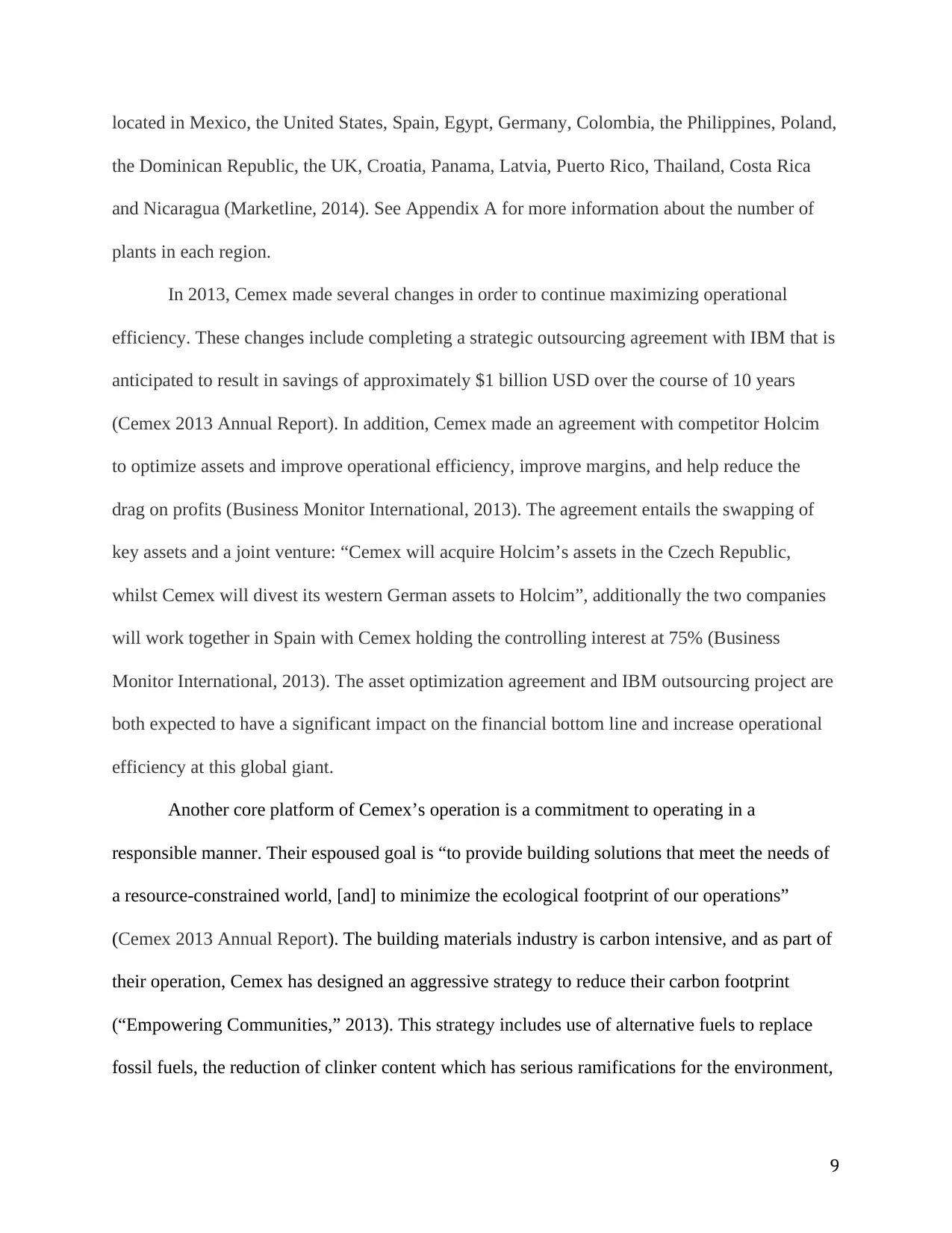
9
located in Mexico, the United States, Spain, Egypt, Germany, Colombia, the Philippines, Poland,
the Dominican Republic, the UK, Croatia, Panama, Latvia, Puerto Rico, Thailand, Costa Rica
and Nicaragua (Marketline, 2014). See Appendix A for more information about the number of
plants in each region.
In 2013, Cemex made several changes in order to continue maximizing operational
efficiency. These changes include completing a strategic outsourcing agreement with IBM that is
anticipated to result in savings of approximately $1 billion USD over the course of 10 years
(Cemex 2013 Annual Report). In addition, Cemex made an agreement with competitor Holcim
to optimize assets and improve operational efficiency, improve margins, and help reduce the
drag on profits (Business Monitor International, 2013). The agreement entails the swapping of
key assets and a joint venture: “Cemex will acquire Holcim’s assets in the Czech Republic,
whilst Cemex will divest its western German assets to Holcim”, additionally the two companies
will work together in Spain with Cemex holding the controlling interest at 75% (Business
Monitor International, 2013). The asset optimization agreement and IBM outsourcing project are
both expected to have a significant impact on the financial bottom line and increase operational
efficiency at this global giant.
Another core platform of Cemex’s operation is a commitment to operating in a
responsible manner. Their espoused goal is “to provide building solutions that meet the needs of
a resource-constrained world, [and] to minimize the ecological footprint of our operations”
(Cemex 2013 Annual Report). The building materials industry is carbon intensive, and as part of
their operation, Cemex has designed an aggressive strategy to reduce their carbon footprint
(“Empowering Communities,” 2013). This strategy includes use of alternative fuels to replace
fossil fuels, the reduction of clinker content which has serious ramifications for the environment,
located in Mexico, the United States, Spain, Egypt, Germany, Colombia, the Philippines, Poland,
the Dominican Republic, the UK, Croatia, Panama, Latvia, Puerto Rico, Thailand, Costa Rica
and Nicaragua (Marketline, 2014). See Appendix A for more information about the number of
plants in each region.
In 2013, Cemex made several changes in order to continue maximizing operational
efficiency. These changes include completing a strategic outsourcing agreement with IBM that is
anticipated to result in savings of approximately $1 billion USD over the course of 10 years
(Cemex 2013 Annual Report). In addition, Cemex made an agreement with competitor Holcim
to optimize assets and improve operational efficiency, improve margins, and help reduce the
drag on profits (Business Monitor International, 2013). The agreement entails the swapping of
key assets and a joint venture: “Cemex will acquire Holcim’s assets in the Czech Republic,
whilst Cemex will divest its western German assets to Holcim”, additionally the two companies
will work together in Spain with Cemex holding the controlling interest at 75% (Business
Monitor International, 2013). The asset optimization agreement and IBM outsourcing project are
both expected to have a significant impact on the financial bottom line and increase operational
efficiency at this global giant.
Another core platform of Cemex’s operation is a commitment to operating in a
responsible manner. Their espoused goal is “to provide building solutions that meet the needs of
a resource-constrained world, [and] to minimize the ecological footprint of our operations”
(Cemex 2013 Annual Report). The building materials industry is carbon intensive, and as part of
their operation, Cemex has designed an aggressive strategy to reduce their carbon footprint
(“Empowering Communities,” 2013). This strategy includes use of alternative fuels to replace
fossil fuels, the reduction of clinker content which has serious ramifications for the environment,
⊘ This is a preview!⊘
Do you want full access?
Subscribe today to unlock all pages.

Trusted by 1+ million students worldwide
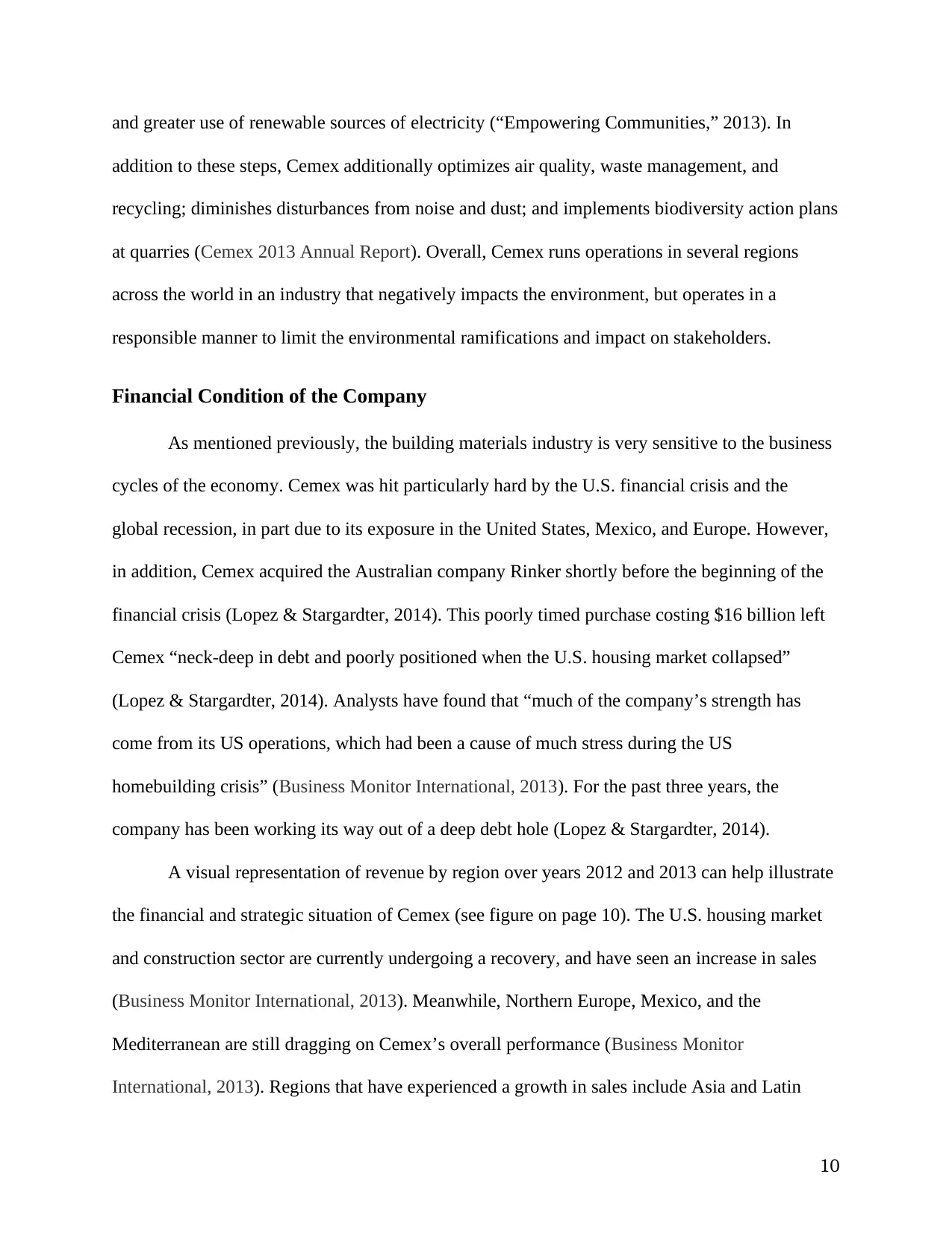
10
and greater use of renewable sources of electricity (“Empowering Communities,” 2013). In
addition to these steps, Cemex additionally optimizes air quality, waste management, and
recycling; diminishes disturbances from noise and dust; and implements biodiversity action plans
at quarries (Cemex 2013 Annual Report). Overall, Cemex runs operations in several regions
across the world in an industry that negatively impacts the environment, but operates in a
responsible manner to limit the environmental ramifications and impact on stakeholders.
Financial Condition of the Company
As mentioned previously, the building materials industry is very sensitive to the business
cycles of the economy. Cemex was hit particularly hard by the U.S. financial crisis and the
global recession, in part due to its exposure in the United States, Mexico, and Europe. However,
in addition, Cemex acquired the Australian company Rinker shortly before the beginning of the
financial crisis (Lopez & Stargardter, 2014). This poorly timed purchase costing $16 billion left
Cemex “neck-deep in debt and poorly positioned when the U.S. housing market collapsed”
(Lopez & Stargardter, 2014). Analysts have found that “much of the company’s strength has
come from its US operations, which had been a cause of much stress during the US
homebuilding crisis” (Business Monitor International, 2013). For the past three years, the
company has been working its way out of a deep debt hole (Lopez & Stargardter, 2014).
A visual representation of revenue by region over years 2012 and 2013 can help illustrate
the financial and strategic situation of Cemex (see figure on page 10). The U.S. housing market
and construction sector are currently undergoing a recovery, and have seen an increase in sales
(Business Monitor International, 2013). Meanwhile, Northern Europe, Mexico, and the
Mediterranean are still dragging on Cemex’s overall performance (Business Monitor
International, 2013). Regions that have experienced a growth in sales include Asia and Latin
and greater use of renewable sources of electricity (“Empowering Communities,” 2013). In
addition to these steps, Cemex additionally optimizes air quality, waste management, and
recycling; diminishes disturbances from noise and dust; and implements biodiversity action plans
at quarries (Cemex 2013 Annual Report). Overall, Cemex runs operations in several regions
across the world in an industry that negatively impacts the environment, but operates in a
responsible manner to limit the environmental ramifications and impact on stakeholders.
Financial Condition of the Company
As mentioned previously, the building materials industry is very sensitive to the business
cycles of the economy. Cemex was hit particularly hard by the U.S. financial crisis and the
global recession, in part due to its exposure in the United States, Mexico, and Europe. However,
in addition, Cemex acquired the Australian company Rinker shortly before the beginning of the
financial crisis (Lopez & Stargardter, 2014). This poorly timed purchase costing $16 billion left
Cemex “neck-deep in debt and poorly positioned when the U.S. housing market collapsed”
(Lopez & Stargardter, 2014). Analysts have found that “much of the company’s strength has
come from its US operations, which had been a cause of much stress during the US
homebuilding crisis” (Business Monitor International, 2013). For the past three years, the
company has been working its way out of a deep debt hole (Lopez & Stargardter, 2014).
A visual representation of revenue by region over years 2012 and 2013 can help illustrate
the financial and strategic situation of Cemex (see figure on page 10). The U.S. housing market
and construction sector are currently undergoing a recovery, and have seen an increase in sales
(Business Monitor International, 2013). Meanwhile, Northern Europe, Mexico, and the
Mediterranean are still dragging on Cemex’s overall performance (Business Monitor
International, 2013). Regions that have experienced a growth in sales include Asia and Latin
Paraphrase This Document
Need a fresh take? Get an instant paraphrase of this document with our AI Paraphraser
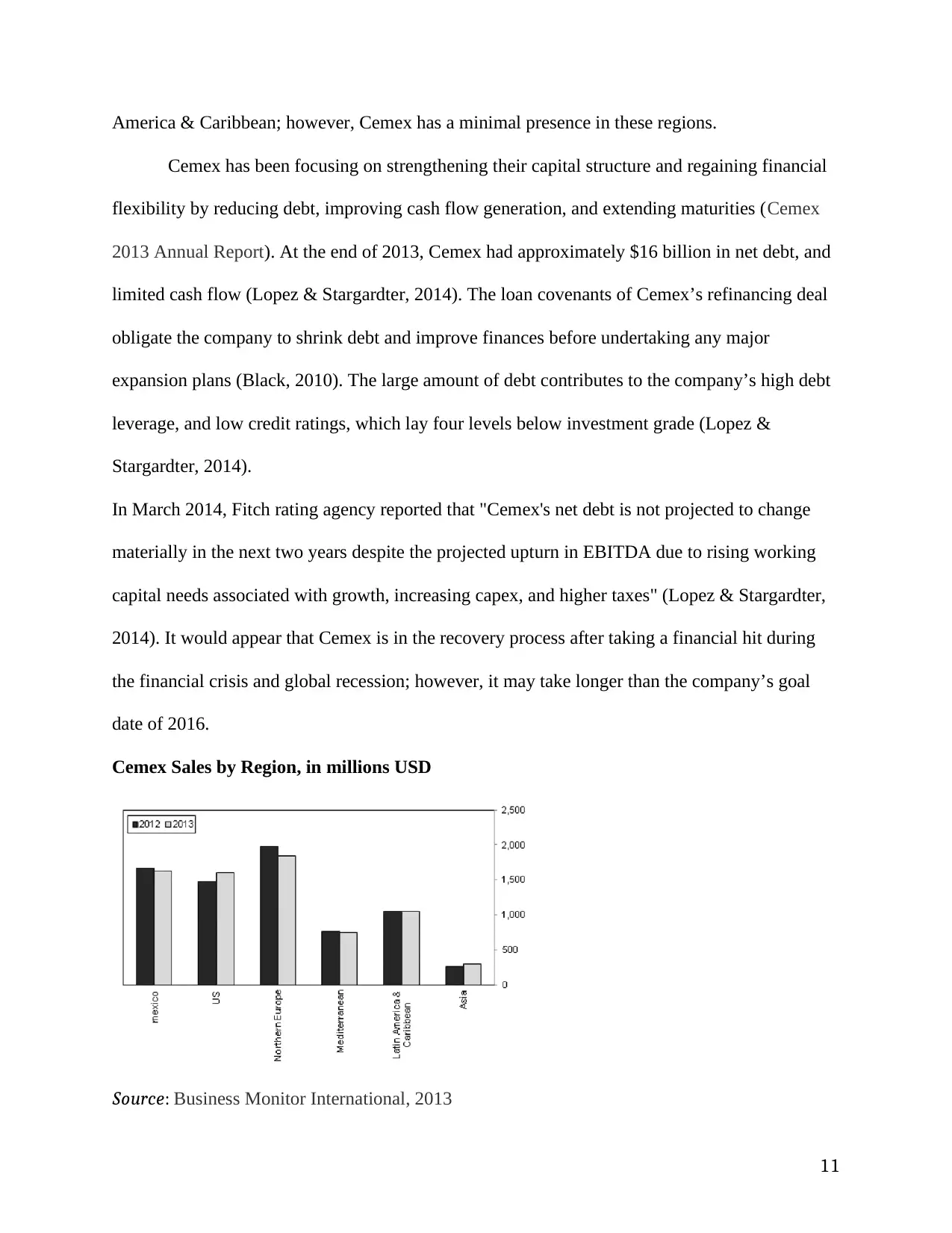
11
America & Caribbean; however, Cemex has a minimal presence in these regions.
Cemex has been focusing on strengthening their capital structure and regaining financial
flexibility by reducing debt, improving cash flow generation, and extending maturities (Cemex
2013 Annual Report). At the end of 2013, Cemex had approximately $16 billion in net debt, and
limited cash flow (Lopez & Stargardter, 2014). The loan covenants of Cemex’s refinancing deal
obligate the company to shrink debt and improve finances before undertaking any major
expansion plans (Black, 2010). The large amount of debt contributes to the company’s high debt
leverage, and low credit ratings, which lay four levels below investment grade (Lopez &
Stargardter, 2014).
In March 2014, Fitch rating agency reported that "Cemex's net debt is not projected to change
materially in the next two years despite the projected upturn in EBITDA due to rising working
capital needs associated with growth, increasing capex, and higher taxes" (Lopez & Stargardter,
2014). It would appear that Cemex is in the recovery process after taking a financial hit during
the financial crisis and global recession; however, it may take longer than the company’s goal
date of 2016.
Cemex Sales by Region, in millions USD
Source: Business Monitor International, 2013
America & Caribbean; however, Cemex has a minimal presence in these regions.
Cemex has been focusing on strengthening their capital structure and regaining financial
flexibility by reducing debt, improving cash flow generation, and extending maturities (Cemex
2013 Annual Report). At the end of 2013, Cemex had approximately $16 billion in net debt, and
limited cash flow (Lopez & Stargardter, 2014). The loan covenants of Cemex’s refinancing deal
obligate the company to shrink debt and improve finances before undertaking any major
expansion plans (Black, 2010). The large amount of debt contributes to the company’s high debt
leverage, and low credit ratings, which lay four levels below investment grade (Lopez &
Stargardter, 2014).
In March 2014, Fitch rating agency reported that "Cemex's net debt is not projected to change
materially in the next two years despite the projected upturn in EBITDA due to rising working
capital needs associated with growth, increasing capex, and higher taxes" (Lopez & Stargardter,
2014). It would appear that Cemex is in the recovery process after taking a financial hit during
the financial crisis and global recession; however, it may take longer than the company’s goal
date of 2016.
Cemex Sales by Region, in millions USD
Source: Business Monitor International, 2013
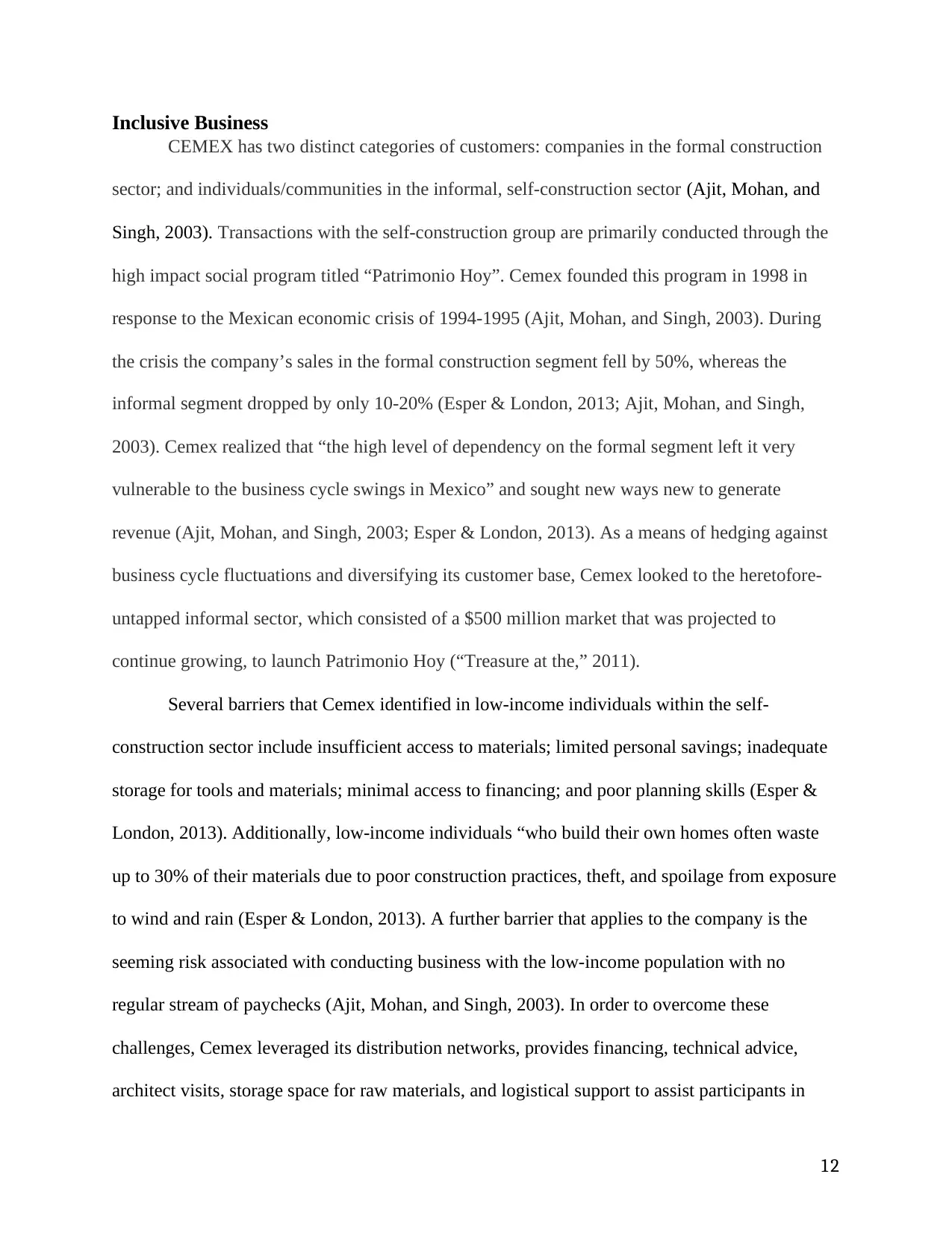
12
Inclusive Business
CEMEX has two distinct categories of customers: companies in the formal construction
sector; and individuals/communities in the informal, self-construction sector (Ajit, Mohan, and
Singh, 2003). Transactions with the self-construction group are primarily conducted through the
high impact social program titled “Patrimonio Hoy”. Cemex founded this program in 1998 in
response to the Mexican economic crisis of 1994-1995 (Ajit, Mohan, and Singh, 2003). During
the crisis the company’s sales in the formal construction segment fell by 50%, whereas the
informal segment dropped by only 10-20% (Esper & London, 2013; Ajit, Mohan, and Singh,
2003). Cemex realized that “the high level of dependency on the formal segment left it very
vulnerable to the business cycle swings in Mexico” and sought new ways new to generate
revenue (Ajit, Mohan, and Singh, 2003; Esper & London, 2013). As a means of hedging against
business cycle fluctuations and diversifying its customer base, Cemex looked to the heretofore-
untapped informal sector, which consisted of a $500 million market that was projected to
continue growing, to launch Patrimonio Hoy (“Treasure at the,” 2011).
Several barriers that Cemex identified in low-income individuals within the self-
construction sector include insufficient access to materials; limited personal savings; inadequate
storage for tools and materials; minimal access to financing; and poor planning skills (Esper &
London, 2013). Additionally, low-income individuals “who build their own homes often waste
up to 30% of their materials due to poor construction practices, theft, and spoilage from exposure
to wind and rain (Esper & London, 2013). A further barrier that applies to the company is the
seeming risk associated with conducting business with the low-income population with no
regular stream of paychecks (Ajit, Mohan, and Singh, 2003). In order to overcome these
challenges, Cemex leveraged its distribution networks, provides financing, technical advice,
architect visits, storage space for raw materials, and logistical support to assist participants in
Inclusive Business
CEMEX has two distinct categories of customers: companies in the formal construction
sector; and individuals/communities in the informal, self-construction sector (Ajit, Mohan, and
Singh, 2003). Transactions with the self-construction group are primarily conducted through the
high impact social program titled “Patrimonio Hoy”. Cemex founded this program in 1998 in
response to the Mexican economic crisis of 1994-1995 (Ajit, Mohan, and Singh, 2003). During
the crisis the company’s sales in the formal construction segment fell by 50%, whereas the
informal segment dropped by only 10-20% (Esper & London, 2013; Ajit, Mohan, and Singh,
2003). Cemex realized that “the high level of dependency on the formal segment left it very
vulnerable to the business cycle swings in Mexico” and sought new ways new to generate
revenue (Ajit, Mohan, and Singh, 2003; Esper & London, 2013). As a means of hedging against
business cycle fluctuations and diversifying its customer base, Cemex looked to the heretofore-
untapped informal sector, which consisted of a $500 million market that was projected to
continue growing, to launch Patrimonio Hoy (“Treasure at the,” 2011).
Several barriers that Cemex identified in low-income individuals within the self-
construction sector include insufficient access to materials; limited personal savings; inadequate
storage for tools and materials; minimal access to financing; and poor planning skills (Esper &
London, 2013). Additionally, low-income individuals “who build their own homes often waste
up to 30% of their materials due to poor construction practices, theft, and spoilage from exposure
to wind and rain (Esper & London, 2013). A further barrier that applies to the company is the
seeming risk associated with conducting business with the low-income population with no
regular stream of paychecks (Ajit, Mohan, and Singh, 2003). In order to overcome these
challenges, Cemex leveraged its distribution networks, provides financing, technical advice,
architect visits, storage space for raw materials, and logistical support to assist participants in
⊘ This is a preview!⊘
Do you want full access?
Subscribe today to unlock all pages.

Trusted by 1+ million students worldwide
1 out of 40
Related Documents
Your All-in-One AI-Powered Toolkit for Academic Success.
+13062052269
info@desklib.com
Available 24*7 on WhatsApp / Email
![[object Object]](/_next/static/media/star-bottom.7253800d.svg)
Unlock your academic potential
Copyright © 2020–2025 A2Z Services. All Rights Reserved. Developed and managed by ZUCOL.





